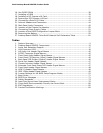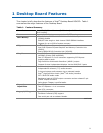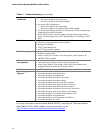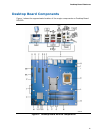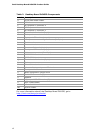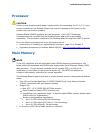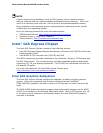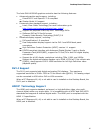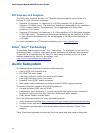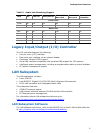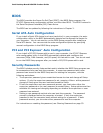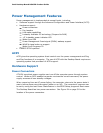
Intel Desktop Board DG45ID Product Guide
16
PCI Express x16 Graphics
The GMCH also supports an add-in PCI Express discrete graphics card via the PCI
Express 2.0 x16 connector as follows:
• Supports PCI Express 1.1 frequency of 1.25 GHz resulting in 2.5 Gb/s each
direction (500 MB/s total). The maximum theoretical bandwidth on the interface is
4 GB/s in each direction simultaneously, for an aggregate of 8 GB/s when
operating in x16 mode.
• Supports PCI Express 2.0 frequency of 2.5 GHz resulting in 5.0 Gb/s each direction
(1000 MB/s total). The maximum theoretical bandwidth on the interface is 8 GB/s
in each direction simultaneously, for an aggregate of 16 GB/s when operating in
x16 mode.
For more information on PCI Express technology, go to http://pcisig.com
.
Intel
®
Viiv™ Technology
The Desktop Board supports Intel
®
Viiv™ technology. To be eligible for the Intel Viiv
technology brand, a system must meet certain hardware and software requirements.
To get the list of requirements for Intel Viiv technology branding as well as all the
features supported by Intel Viiv technology, visit
http://intel.com/products/viiv/index.htm
.
Audio Subsystem
The onboard audio subsystem consists of the following:
• Intel ICH10R I/O controller hub
• IDT 92HD73E audio codec
• Intel High Definition Audio front panel audio header
• Intel High Definition Audio Link header
• Onboard 3-pin S/PDIF output connector
• Back panel audio connectors including an optical S/PDIF output connector
The audio subsystem supports the following features:
• A signal-to-noise (S/N) ratio of 95 dB
• Independent multi-streaming 7.1 audio (using the back panel audio connectors)
and stereo (using the Intel High Definition front panel audio header)
• Dolby Home Theater certified audio
Go to the following locations for more information about:
• Audio drivers and utilities http://support.intel.com/support/motherboards/desktop/
• Location of the onboard audio headers, Figure 21 on page 44
• The location and description of the
back panel audio connectors, Figure 22 on
page 49
Table 3 lists the supported functions for the front panel and back panel audio jacks.



